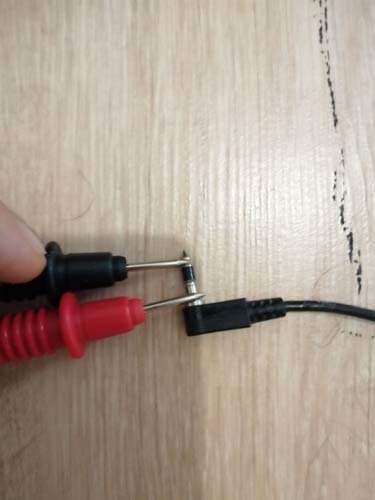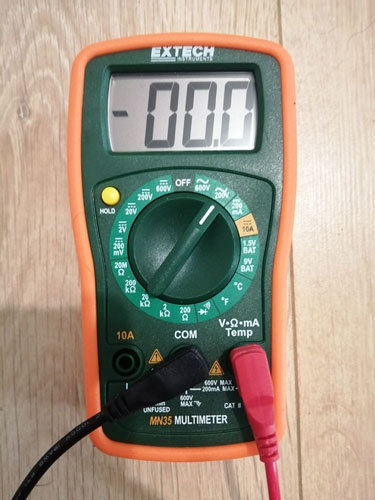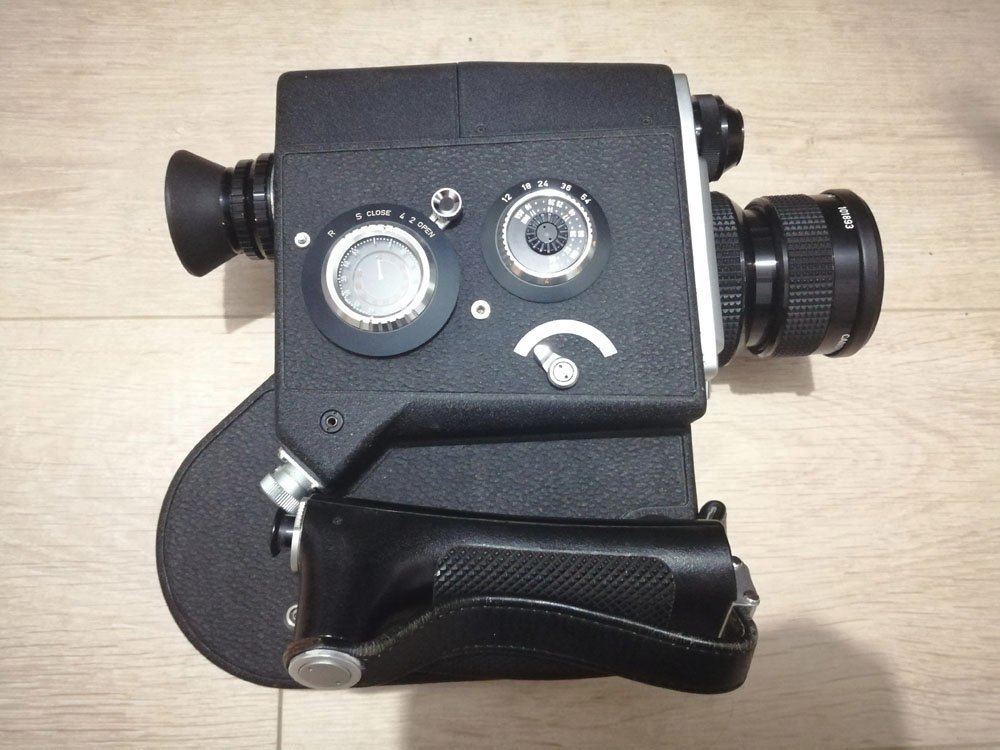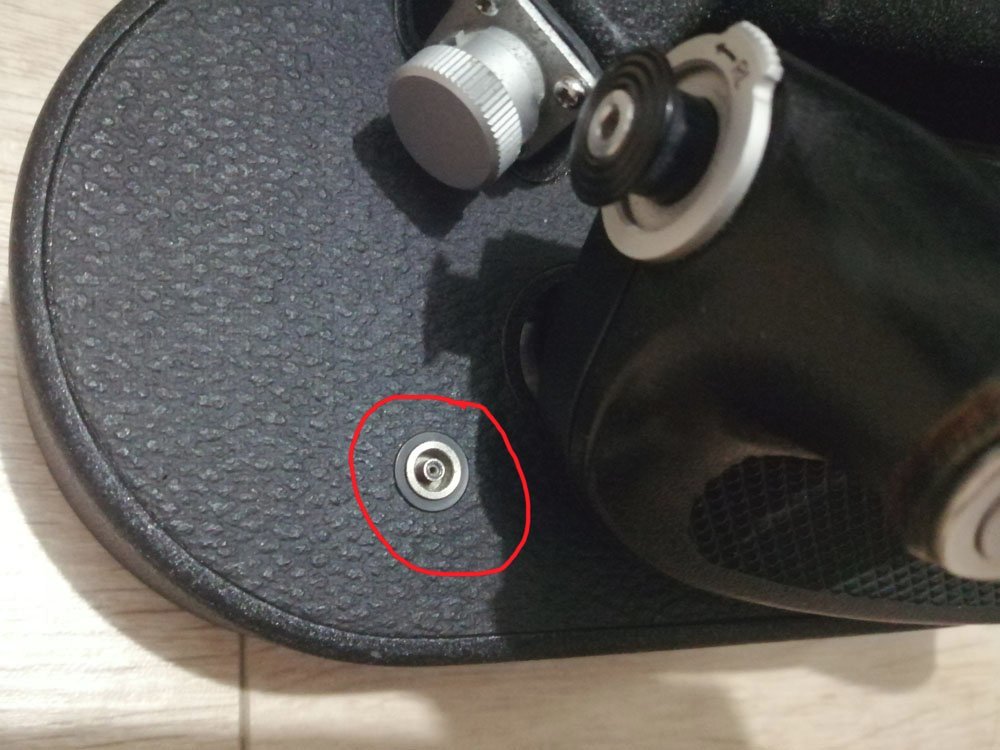-
Posts
29 -
Joined
-
Last visited
Everything posted by Jeremy Saint-Peyre
-

Triggering a digital audio recorder on a Canon Zoom DS-8
Jeremy Saint-Peyre replied to Jeremy Saint-Peyre's topic in Super-8
I'm back on my feet ! Thanks for the idea Helge, do you have any exemple that you shot with your Nizo and the PWM Impulse WSFG-06 i can look at ? I like how the idea is simple and elegant. How does the pre-recording actually work ? Doesn't it make it hard to sync with the footage in post ? -
Hello everyone, I am home processing 16mm, mostly Fomapan R100, and i am also home brewing my chemistery (hardening bath, bleach, clearing, developper is a photo paper one) : Sulfuric Acid, Potassium Permanganate, Potassium Alun, Sodium hexametaphosphate, Sodium Bisulphate and Sodium Metabisulphite. I use caoutchouc gloves (the pink kind you use for house cleaning) and safety goggle. My question is more about the mask and filter, i use this mask : https://www.cazabox.com/47353-demi-masque-a-filtre-nu-avec-soupape-d-expiration-sup-air.html and those filters : https://www.cazabox.com/7160-galette-filtrante-ammoniac-en14387-vendu-par-2-sup-air.html. What are your opinions/gear ? Thanks, Jeremy
-

Triggering a digital audio recorder on a Canon Zoom DS-8
Jeremy Saint-Peyre replied to Jeremy Saint-Peyre's topic in Super-8
Thank you Helge, i'm discovering your solution, i'll look into it ! Sorry for the late reaction... -

Triggering a digital audio recorder on a Canon Zoom DS-8
Jeremy Saint-Peyre replied to Jeremy Saint-Peyre's topic in Super-8
Hello everyone ! I was on a trip but now i'm back at it. I will carefully read ad try to understand Phil and Aapo post. I've just ordered the Arduino Nano 33 IdO and an Arduino Uno kit ! -

Triggering a digital audio recorder on a Canon Zoom DS-8
Jeremy Saint-Peyre replied to Jeremy Saint-Peyre's topic in Super-8
Thank you for the informations ! So i guess this one will do the job : https://www.distrelec.ch/en/arduino-nano-33-iot-arduino-abx00027/p/30150883?no-cache=true&marketingPopup=false&queryFromSuggest=true I did some arduino based project... but i was more on the cutting/screwing/assembling parts side. I am aware of the code side, so i'll put my mind at it, and if you can help a bit i'll be thankfull ! I'm also sourcing materials and arduino for an other project, a telecinema based on Denis Carl (http://www.deniscarl.com/dokuwiki/doku.php?id=start) opensource telecinema and on a version done by a friend. So, i have no choice but to put myself into coding ! -

Triggering a digital audio recorder on a Canon Zoom DS-8
Jeremy Saint-Peyre replied to Jeremy Saint-Peyre's topic in Super-8
That would have been my choice if i wanted to shoot fiction, but i'm looking to shoot documentary, so i can't clap before/after a shoot in those conditions... -

Triggering a digital audio recorder on a Canon Zoom DS-8
Jeremy Saint-Peyre replied to Jeremy Saint-Peyre's topic in Super-8
That is foreign language to me ? -

Triggering a digital audio recorder on a Canon Zoom DS-8
Jeremy Saint-Peyre replied to Jeremy Saint-Peyre's topic in Super-8
Thank you, so if you both think it is still doable, i'm going to get in it. As i don't know where to start, wich arduino card should i use in your opinion ? -

Triggering a digital audio recorder on a Canon Zoom DS-8
Jeremy Saint-Peyre replied to Jeremy Saint-Peyre's topic in Super-8
Thank you for your expertise ! My Zoom H4n do take remote control 2.5mm input, but i have doubt it'll work by plugin it in directly. Also i wanted to stop both recording simultaneously. -

Triggering a digital audio recorder on a Canon Zoom DS-8
Jeremy Saint-Peyre replied to Jeremy Saint-Peyre's topic in Super-8
Thanks, i am not sure i get what it means... The pins are connected mechanically at the moment i trigger the camera ? -

Triggering a digital audio recorder on a Canon Zoom DS-8
Jeremy Saint-Peyre replied to Jeremy Saint-Peyre's topic in Super-8
Hello everybody ! Sorry for the silence, i was looking to put my hand on a multimeter to test the socket on the camera ! So, i know the socket work because i plugged a flash in and it worked : So, to go further in this little project, i just had to mesure the electric power on the flash cord plugged in the socket according to Phil Rhodes, we need to know if it is a a short impulse or a continuous delivery. Here is the multimeter, i put it on 200V AC: here is the cord : It got me and absolute ZERO : So i guess, my question is : What am i doing wrong ? -

Triggering a digital audio recorder on a Canon Zoom DS-8
Jeremy Saint-Peyre replied to Jeremy Saint-Peyre's topic in Super-8
What do you mean ? -

Triggering a digital audio recorder on a Canon Zoom DS-8
Jeremy Saint-Peyre replied to Jeremy Saint-Peyre's topic in Super-8
The H4n do have a remote input as there is a remote available : https://zoomcorp.com/en/gb/accessories/power-accessories/rc4/ It may be a 3.5mm, but if needed, an adapter 3.5mm to 2.5mm should do it. -

Triggering a digital audio recorder on a Canon Zoom DS-8
Jeremy Saint-Peyre replied to Jeremy Saint-Peyre's topic in Super-8
Allright, i going to try your option, it seems it can be done relatively quickly and it would give me what i need (start and stop the audio recording according to the camera) I do not know if it is just a closing contact... how can i know that ? Plug a cable, make the camera run and use a multimeter to see if there is short hight tension or a continuous one ? For the cable, i may have an old canon synchroflash cable with 2.5mm on one end. Otherwise, here are some options : https://www.bhphotovideo.com/c/product/1332403-REG/pluto_pc_cable_flash_pc_sync_cable.html https://www.bhphotovideo.com/c/product/1015044-REG/nero_trigger_cable_flash_cable_for_flash_units.html https://www.bhphotovideo.com/c/product/1494317-REG/tentacle_sync_c20_gh5s_tentacle_to_flash.html https://www.missnumerique.com/miops-smart-cable-de-declenchement-pc-sync-pour-flash-p-29013.html And for the H4n side that is less simple, where should i start ? As the previous board is sold out, would this one https://store.arduino.cc/collections/boards/products/arduino-nano-rp2040-connect (also a 3,3v) do it ? I still aim to shoot remotely in the wil, so this mean the board would take it's power from the camera ? From what i understand from the GitHub page, the only thing i need beside the arduino board are the cables ? Many thanks ! Jeremy -

Triggering a digital audio recorder on a Canon Zoom DS-8
Jeremy Saint-Peyre replied to Jeremy Saint-Peyre's topic in Super-8
Well, it is said in the user guide that the flash socket can be used to trigger sound recording, so it was intended in the camera engineering (here on page 28 https://www.manualslib.com/manual/553933/Canon-Zoom-Ds-8.html?page=28#manual). Also, it is true there is a single frame releases possible, the socket is clearly described as a "tape recorder starting socket" (page 3 of the manual). I think you can use it to trigger flash when you do single frame release, and there is also a special socket for "single frame release socket", it is nowhere said in the manual that you can trigger flash, i am just guessing from the socket. On my 814 XL-R there is this possibility, so i assumed it is the same on the DS-8. But it seems i was wrong. -

Triggering a digital audio recorder on a Canon Zoom DS-8
Jeremy Saint-Peyre replied to Jeremy Saint-Peyre's topic in Super-8
Allright, so, let's say i build this Blueduino-RC4 (this would be my cheapest option, as i already have my H4n (not the Pro version) and a microphone), i'd just have to plug it on my camera through the flash socket (it's a synchroflash, it's also used to trigger flash when you do stop motion) and it would trigger the recording on the H4n ? It will be wired like this : Camera --> Blueduino --> H4n The Blueduino being build on this : https://store.arduino.cc/products/arduino-nano-33-ble ? I have absolutly ZERO knowledge in arduino and electrotechnics (but i can shoot homemade glassplate...), so i wonder how i will plug the Blueduino on the camera... And also, i aim to use it in the wild, so without power. Would it be possible to add aapo lettinen features (the sound bleep on start and end) to this solution ? An other problem i'm going to have is i think the vibration from the camera and the noise can be a problem. I cleaned my recording to get rid of the camera noise, but it's heavily done, so i'll buil a blimp to get it if not sound proof, at least sound discret. Thanks again, Jeremy -

Triggering a digital audio recorder on a Canon Zoom DS-8
Jeremy Saint-Peyre replied to Jeremy Saint-Peyre's topic in Super-8
Whao, i wasnt expecting that much feedback in such a short time. I'll make some research based on your comment and i'll get back at you, Thanks a lot ! -
Good evening, I am the happy owner of a Canon Zoom DS-8. Close to the handle, there is a socket, according to the notice (here https://www.manualslib.com/manual/553933/Canon-Zoom-Ds-8.html?page=28#manual) you can trigger a tape recorder simultaneously with the shutter realease, if the remote control cable from the recorder is connected to the camera. The recorder power should be at maximum 24v /0.3A. I succesfully post synchronised 30sec interval by clapping my hands while recording with my H4n nearby, results here (in french...) : My goal is to have an on camera microphone with a digital recorder triggered by the camera... The cherry on top of the cake would be to have the sound recorder to stop record when the shutter realease button is reasleased. I have no idea where to start. I guess i should invest in a basic recorder on wich i can plug my Rode microphone ? I am a photographer, i'm kind of new in the movie camera/sound sychro game so any opinions or leads are welcome ! Thanks ! Jérémy
-

Canon 814 XL-S : Crystal synchro + Max 8 gate
Jeremy Saint-Peyre replied to Jeremy Saint-Peyre's topic in Super-8
Hello Martin ! Thanks for your answer, I'll give it a try this way with the crystal synch of the camera. My main problem is I want to shoot documentary, so I can expect segment with more than 1min. But, I can take an other artistic direction to cheat that issue. How would you proceed to fill out the gate ? Many thanks, Jeremy -
Hello folks, I just got an email from Pro8mm that they do not offer the 24fps crystal synchro and max 8 film gate modifications. Do any of you know how/where I could get both done at once or separately ? In Europe if possible... Thanks very much Jérémy
-
Yeah, me too, especially it went succesful before. I was suggested on an FB group and o Photrio as well that the bleach A and B concentrations are too high. Sulfuric acid should be at 1% and lowering Permanganate potassium to 2gr/L (or even less at 1gr/L) instead of 4gr/L for 5min... Dichromate are now forbidden to sell and/or to own du to toxicity in UE. That's why i got into de Potassium Permanganate/Sulfuric Acid bleach.
- 3 replies
-
- reversal
- reversal process
- (and 12 more)
-
Hello guys and gals, So, yesterday, while processing some Tri-X Super 8, something nightmareish happened during the second developpement after re-exposure : after 1 min in the 2nd developer (where the emulsion properly reacted and darkened), it slightly started to lift from the plastic and then it litteraly disloved into the developper : no floating gelatin flakes, just a plain black developer... The weird thing is that I already processed Tri-X this way, here is an example : https://vimeo.com/326184819 Here is my protocole, I have included as much info as I can : 1 – Soaking in a 25°C water bath. 2 – 1st Developer : Ilford Multigrad 1+9, 20min (continuous agitation on 1st minute, then 10sec each minute), 25°C. 3 – Hardening stop bath : Adox EcoStop 1+29 + 40ml/L of Tetenal Hardener. 6 min, 20°C, continuous agitation. (https://www.fotoimpex.com/chemistry/tetenal-hardener-to-be-added-to-the-fixer-or-stop-bath-1000-ml.html?cache=1564733928) 4 – Washing, runing water, 2 minutes. 5 – Bleach : Potassium permanganate 0,4% + Sulfuric Acid 10% equal part, 6 min, 20°C, continuous agitation. 6 – Washing, runing water, 2 minutes. 7 – Clearing bath, Sodium metabisulfite 6%, 2 min, 20°C, continous agitation. 8 – Washing, runing water, 2 minutes. 9 – Hardening stop bath : Adox EcoStop 1+29 + 40ml/L of Tetenal Hardener. 6 min, 20°C, continuous agitation. 10 – Washing, runing water, 2 minutes. RE-EXPOSURE : 2x1min 80W 1m in a white tank filled with water. 11 – 2nd Developer : Ilford Multigrad 1+9, 4min (stand), 25°C. The same solution I used as 1st developer. And that's where the emulsion dissolved.... Usually, after that, I use an hardening fixer for 5 minute, washing 10 min on runing water, rinse with distilled water, let it dry and digitalise with a Retroscann Universal. It's fastidious, but cheap ! Side notes : - Processing in Lomo Tank. - I know Ilford says not to use Ilford Multigrade for processing film (Universal PQ is recommanded instead), but through my test phase it was the only thing I had on hand, so I tried and it worked as you could see on vimeo. - I've never found any information about the shelf lif of the Tetenal hardener. As it is supposed to be mixed with Stop or Fix, I mixed it with the Adox Eco Stop to be sure I won't use an hardening bath tha is no longer working. Anyway, I mixed a new solution and it was still a disaster. - I use the hardener to compensate the softening of the emusion by the bleach. One bath before to strenghten, one bath after to reinforce. I thing the bleach isnt to blame, otherwise it the continous agitation in the clearing bath would have the same mechanical effect, so I guess it is a chemistery issue. The film is perfectly fine during re-exposure, bleaching is complete, after touching the film, the emulsion is normal. - I dont know why the developper is dissolving the emulsion on second use but work perfectly fine on the first one. So that's it, if anyone have an idea, i'm all ears ! Thanks ! Jérémy
- 3 replies
-
- reversal
- reversal process
- (and 12 more)
-

Lomo Reloadable Cartridge modifications / Canon 814 XL-S
Jeremy Saint-Peyre replied to Jeremy Saint-Peyre's topic in Super-8
Thanks, i guess thoses ones work : http://www.wittnercinetec.com/epages/WittnerCinetec-Super8-16mm-Film.sf/en_GB/?ObjectPath=/Shops/WittnerCinetec-Super8-16mm-Film/Products/1132







